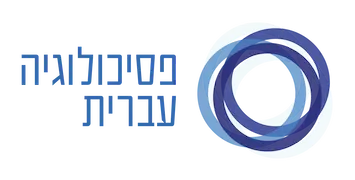
Benjamin Kilborne: התרשמויות (וגם חלומות, נוכחות טיפולית, וטיפול מרחוק)
ארנון רולניק | 6/12/2014 | הרשמו כמנויים
הפוסט הזה מבקש להיעזר בתחושותיכם.
נכיר כאן את Benjamin Kilborne : פעם בטקסט, פעם בקול ופעם בוידאו. ארצה גם לבקש מכם להתבונן בתהליך ההכרות : נתעניין איך הרגשתכם כלפיו עשויה להשתנות.
תהיה זו הכנה טובה לקראת במפגש קרוב שיתקיים ב 15 לפברואר שבו נעמיק בשאלת הנוכחות הטיפולית בכלל ולשאלת הנוכחות בטיפול מרחוק בפרט.
התוכן שיעלה בפוסט זה יהיה קשור לחלומות אולם העניין האמיתי שלי יהיה סביב שאלות ה"איך" .
דומני שכולנו, ידידי, גם הסיביטיסטים וגם הדינמים חוטאים ב"קידוש התוכן":
הרבה טבלאות א.מ.ת (ארוע מחשבה תגובה) נכתבו בעולם הקוגניטיבי ועוסקות בתוכן המחשבות.
הרבה נכתב בעולם האנליטי על חשיבות האינטרפרטציה. ומרבית האינטרפרטציות וורבליות ומקדשות את המילים
בהדרכה, כדי להכיר את האיך או את הדרך בה מתנהל הטיפול ניתן להציע לפעמים למודרך לומר בקול רם את ההתערבות הטיפולית שעשה. כאילו להיכנס למשחק תפקידים. כשזה מתאים, ניתן לצפות או לשמוע את הפגישה המוקלטת. בעצם אני מבקש לרגע להיות מעין "זבוב על קיר חדר הטיפולים" הצופה באינטראקציה הטיפולית.
אני סקרן להכיר את המבט העצוב/חרד/מלא חיים של המטופל ואני מקווה לראות את הפנים השואלות–דואגות-מתעניינות של המטפל. אני קשוב לקול של המטופל. לאינטונציות שלו, לרגעים שקולה עולה או יורד. לקול הרועד ולקול המתרונן.
אצל המטפל אני מקווה לשמוע מספר קולות הרך, משקף, מארגן וסמכותי. ויותר מכל אני רגיש לסינכרון או העדרו: לקצב בו המטופל והמטפל מדברים להתמסרות העדינה בין מסרים ואמירות.
ניסוי קטן
אני רוצה להזמין את חבריי בפסיכולוגיה עברית לניסוי קטן: לניסוי זה אזמין את Benjamin Kilborne לדבר עימנו בשלוש דרכים:
א. האחת בכתיבה, נביא חלק מדבריו בנושא חלומות ואתעניין בהתרשמותכם מדבריו.
זו תהיה הזדמנות לעסוק בתוכן בלבד – ועד כמה ההתנסחות המילולית של מטפל זה מדברת אליכם
ב. לאחר מכן, נשמע את קולו מדבר על אותו נושא בדיוק ונתעניין איך המימד האודיטורי הוסיף או גרע מהתרשמותכם.
ג. בשלב השלישי נכניס את הוידאו לתמונה ונראה את Kilborne מסביר על חלומות בשיחה מרחוק. גם כעת נשאל על ההתרשמות מהאיש.
רוצה להוסיף אסוציאציה: אני מגיע ללא מעט כנסים. מבחינתי אחת ממטרות הכנס היא להכיר את האיש מאחורי הכתיבה. בדרך כלל – מבלי שבחרתי בזאת - אני מוצא עצמי שואל איך זה יהיה להרגיש כמטופל שלו או כמודרך שלו.
הבה נתחיל מפגש עם הטקסט של Kilborne
הנה טקסט שכתב Benjamin Kilborne בכוונה איני נותן עליו כעת עוד פרטים. סבלנות (חיוך). אנא קראו את הטקסט וחשבו איזה מטפל מתגלה לנו כאן?
I am not attempting to define what a dream is, I wanted to wait until we have time to explore various aspects of dreams and dreaming including doubts in dreams before we ung onto the dicey matter of defining dreams. If dreams were creatures then the dreams would be a nocturnal animal that comes out when we sleep. However there is no observational definition of dreams that is come close to what we all know adream to be. This is because nobody, including the dreamer can know a dream while dreaming it. Or by watching the dreamer dream. Our very of conception of knowledge entails consciousness and that's precisely what we do not have when we dream. But can there not be a form of knowledge outside of what we define as consciousness…..
Now what about physiological definitions of dreams? Neurophysiologists who study sleeps and dreams had identified a particular phase of sleep which they associated with dreaming. This is what's known as REM sleep, the sleep phase associated with rapid eye movements. Because researchers have correlated dream activity as picked up in brain imaging with rapid eye movements, many tend to see blimps on a screen as evidence of dreaming. However, there are two problems with assumptions based on this correlation. First researchers assume that because the subject awakened in the REM phase of sleep tend to remember their dream better, it is further assumed that they were actually dreaming when the researchers saw brain activity and correlated it with rapid eye movements. This may or may not be the case. It may equally may be that the dream was a function of having being awakened. The second objection is more fundamental still. Brain and sleep researches tend to think that a dream can be define as they observe it- as brain activity picked up on monitors and as rapid eye movements. Epistemologically, dreams can never be observe directly. scientists can only focus on what they define to be- the manifestation of brain activity. This leave dreams on a black box. The consciousness of one person can never be a substitute of the lack of consciousness on another. Because the researcher is awake, how can he know at that time in the sleep of his unconscious subject? Furthermore, what we want is a definition of what we all experience as dream and dreaming, so ho such a definition eludes us become rather important. Is there a problem with language? What kind of conceptual difficulties do we encounter in describing what we are now calling a dream? And what does consciousness have to do with our difficulties in defining a dream?
Now, let us look at what dictionaries tell us about dreams. The Oxford English dictionary defines a dream as "series of thoughts, images, sensations or emotions accruing in the mind during sleep". The definition covers all bases in provide that sort of omnibus approach that may be useful of a linguist wanting not to make a mistake, but leaves the rest of us wondering. What do we know that is not a image, a sensation, a thought or an emotion? It seems that dreams can form all other knowledge except that they came in sleep. There is human knowledge and experience obtain in sleep. What kind of difference does that make? Why? How? Bering these questions in mind, let's have a look at a etymological dictionaries and see what light they might shed. The word dream can be traced in old English to midst thirteen century. As a verb to dream it is probably related to the old Norse draumr, Danish drøm, the Swedish dröm. Some believe it's related to the German word trume. If we look at the etymology of the of the German word trume meaning dream it is related to the Greek word trauma, meaning wound, something pierced. Follow the logic suggested by etymology then it would appear that dreams can be traumatic, and even associated with psychic wounds, as in nightmares or anxiety dreams. We can also imagine that they pierce our conscious sense of ourselves by opening out on to another world. Now this should come as no real surprise as we've seen in the tradition of Asclepius and the practice of incubation or healing in dreams how integral parts in conception of sickness and healing dreams were assume to have and how they were believed to reach far beyond the world of ordinary daily life. Bur the old English word dream also correspond to the old Saxon word drom, meaning not only dream but also joy, gladness, mirth and music. Not only music but melody and sound. So, it would seem that if we follow out the logic at these etymologies we come out with antithetical meanings. One line of thought brings us to trauma and injury, the other to joy and music. From our contemporary average point, with our focus on the divide between illness and joy, medicine and the arts, it would seem that there is no way of reconciling the two lines of thought. However, If we look closer it become conceivable that in the classical world notions of sickness and close also possibilities of joy and music, and all three concepts indicate relations to a world beyond. We know that in the incubation sites known in Greek as the abatan, the incubation places were pilgrims slept in order to have cure in dreams were also part of temple complexes that included theaters , and that theater, dance and music were integral to the practice of incubation. For the ancient Greeks illness, like theater, dance and music provided an opportunity for the connection with the beyond. Furthermore, the celebration of such connection constitute for a major interest in the practice of all the arts- the art of healing being only one.
נמשיך להאזנה ל Kilborne
ועכשיו אני מציע לכם לשמוע את Benjamin מספר על הנושא בקולו – הפעם זה קצת ארוך יותר. נסו לתת לעצמכם להקשיב . יחד עם העניין שתגלו, אני מניח בתוכן, שימו לב לאינטונציה, לפרוזודיה, ונסו לדמיין את ההרגשה להיות מטופלים או מודרכים שלו.
ועתה אשמח אם תענו שוב על השאלה איזה הרגשה תהיה להיות מטופלים או מודרכים שלו.
-----
מפגש פנים עם Benjamin Kilborne
השלב האחרון מפגש פנים אל פנים עם Benjamin האם כך דימיינתם אותו? כיצד מפגש ויזואלי זה מוסיף או משנה את התרשמותכם ממנו. ושוב נסו לדמיין את ההרגשה להיות מטופלים או מודרכים שלו.
אז מה היה לנו כאן?
עסקנו קצת חלומות , אך בעיקר היתה לנו כאן הזדמנות לפרק את הנוכחות הטיפולית לכמה מרכיבים. מרכיבי התוכן , מרכיבי הנוכחות הקולית ומרכיב הנוכחות הקשורה במראה .
ובכן זה בדיוק הנושא שבו הקליניקה שלי עסוקה כעת. האם ניתן ללמוד ואולי גם לתת פידבק על סוג הנוכחות הטיפולית
במפגש הקרוב שיתקיים ב 15 לפברואר נשמע את Benjamin Kilborne . מדבר בדיוק על הסוגיה הזו של הנוכחות הטיפולית כפי שהוא לומד אותה מטיפולי הסקייפ שהוא עושה .
ועכשיו הנה קצת פרטים עליו
Kilborne הוא פסיכואנליטיקאי מוסמך מטעם International Psychoanalytic Association והוא העורך של The American Journal of Psychoanalysis . הוא קודם כל איש של מוזיקה ותחום שהוא מגדיר כ EthnoPsychiatry. למד בסורבון ובארה"ב וכן הוא מרצה ברחבי העולם. כתב מספר ספרים בינהם Disappearing Persons: shame and appearance
פסיכואנליטיקאי זה החליט לעשות חלקים נרחבים של הטיפול שלו באמצעות סקיייפ והנה מה שהוא כותב:
Skype provides an extraordinary medium in which to practice psychoanalysis, psychotherapy and psychoanalytic supervision, since it is possible for two people to see each other while speaking. Some psychoanalysts have equated psychoanalysis with the use of the couch but rather in the quality of the relationship and in the nature of the psychoanalytic process. However, there are other analysts who have found that eye contact can be essential in fostering the analytic process, and that its lifeblood is not in the number of sessions or the use of the couch, but rather in the nature of the psychoanalytic process.
והוא מסכם:
Conventional psychoanalysis is practiced without eye contact but with presence; Skype psychoanalysis, is practiced with eye contact but without presence.
כפי שניתן להבין שאלות אלו מתכתבות עם שאלת הטיפול מרחוק. מסתבר שנושא השימוש בקול בלבד בטיפול מרחוק (כלומר באמצעות הטלפון) הוא ממש לא זר לתרבות הטיפולית, ובסקר שנערך בקרב חברי החברה הפסיכואנליטית הבריטית נמצא כי מעל 30 אחוז מאנליטיקאים אלו משתמשים בטיפול מרחוק (אם בטלפון ואם בסקייפ).

